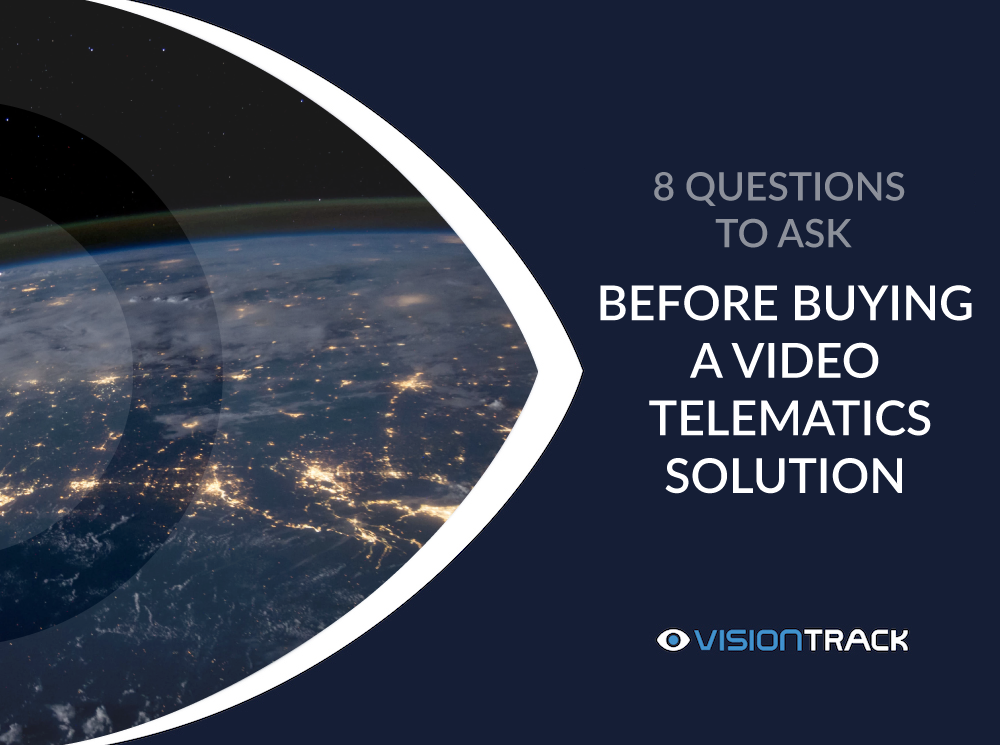8 QUESTIONS TO ASK BEFORE BUYING A VIDEO TELEMATICS SOLUTION
Written by VisionTrack
30 July 2019
Choosing a video telematics solution has become complicated of late. With an increasingly crowded marketplace, there are a growing number of connected vehicle cameras and multi-channel mobile DVR systems all claiming to be “industry-leading” or “next generation”. In reality, there are big differences in terms of the quality, reliability and functionality, while each potential technology partner will typically have a different approach and varying levels of expertise and experience.
Making the right choice needs careful consideration to ensure you select a high-quality solution that is backed by the best service and support. With this in mind, there are a number of questions you should be asking a potential technology partner to cut through the confusion and help make a better-informed decision:
1. Do you offer a wide range camera solutions?
One size rarely fits all. Every fleet is different in terms of vehicle make-up and usage, so make sure your preferred partner has the tools available to create a video telematics solution that meets your precise needs. Having access to a wide range of connected forward-facing vehicle cameras, multi-channel cameras, mobile DVRs and blindspot/cyclist detection systems makes it possible to take a tailored and flexible approach to your fleet requirements.
2. Is your software platform device agnostic?
You really don’t want to end up with multiple systems just to use your vehicle cameras. Choosing a hardware agnostic platform means the software is compatible with all forward-facing and multi-camera solutions, mobile DVRs and cyclist detection systems, as well as third-party technology such as tracking or electronic vehicle systems. This ensures all the video footage and supporting telematics data is in the same place, whatever hardware solution you select, so you can make the most of your investment.
3. How secure is your hardware and software?
Security is a critical consideration for any video telematics solution to protect devices and the captured data. All connected vehicle cameras should be fully-lockable to prevent prohibited access by drivers or third parties to internal SIM cards and SD cards/hard drives. On top of this, all video footage and supporting data on the device needs to be encrypted to ensure that only authorised users can access it through approved software, while every transmission over the mobile phone network is secure.
4. Is the software developed and supported in-house?
Find out if your video telematics partner owns the software or if they are dependent on a third- party manufacturer. This is a critical consideration, especially if the software needs to be installed locally rather than being in the cloud, because new updates or any issue resolution could end up being a painstaking process. Also, if the software is not designed and maintained within the EU, you will need consider the implications with regards to your GDPR responsibilities and internal IT policies.
5. Do you provide industrial-grade storage and IoT connectivity?
When selecting your vehicle cameras, establish if they use industrial-grade SD-cards and IoT SIM cards to ensure they are suitable for commercial and connected applications that meet the demands of a professional fleet operation. Try to avoid internal storage that is designed for consumer applications – for example, TLC (Triple Level Cell) SD-cards – that are prone to high failure rates and lack the durability and performance of an industrial-grade solution such as the MLC (Multi Level Cell) SD-card. Meanwhile, IoT SIM cards – also known as M2M SIM cards – are the best option to provide the connectivity required to automate processes and communicate between different devices.
6. Do you use lithium batteries within your camera technology?
Lithium-Ion batteries in vehicle cameras are suspected of causing a number of fires in parked cars as a result of overheating, in one instance prompting a recall of as many as 85,000 devices in Japan. There is a real risk to both your drivers and fleet assets, so it is worth considering supercapacitor batteries as an alternative battery back-up. A supercapacitor can operate safely at more extreme temperatures.
7. Do you provide any complementary support services?
Check whether any complementary services are available alongside a video telematics solution, so you can make the most of your connected vehicle cameras. We have found, for example, that some fleet operations lack the resources internally to review and respond to multiple alerts. If this sounds familiar, then it might be worth considering support services such as a monitored
FNOL (First Notification of Lost) solution that can significantly reduce claim reporting times, better manage claims costs and unlock the true savings potential.
8. Do you have client testimonials?
Positive client testimonials provide peace of mind that a technology partner can deliver on its service promise. They not only demonstrate that a business has been operating successfully for some time – an unproven start-up is unlikely to have any customer success stories – but also provide useful insight into how video telematics could work for you. This should help you overcome any doubts you have and give you confidence that a potential partner is the right choice.
VisionTrack is the leading provider of connected vehicle cameras and video telematics. We have the widest choice of advanced, high-quality and reliable vehicle camera technology to help protect vehicles, assets, staff and reputation. These innovative solutions – underpinned by our multi-award winning IoT platform – are proven to deliver true value to any size of fleet or transport operation. This includes improved road safety, reduced insurance costs, enhanced duty of care, lower operational risk, improved driver behaviour and increased fleet efficiency. Why not contact our team to discuss your options and find out how we can help your fleet operation?




